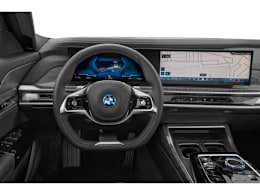Introduction
Ultra-Luxurious 2023 BMW 7 Series and i7
This flagship sedan feels like seventh heaven, whether on electric or gas powerOverview
BMW has charged into the EV market by using its existing platforms to create both gasoline and electric versions, as demonstrated with the redesigned BMW 7 Series and all-new i7. This strategy makes it appear at first glance that BMW is not as committed to EVs as some other manufacturers. However, the 7 and i7 ultra-luxury sedans are both quite impressive, based on our initial driving experience with examples rented from the German automaker. And there are dedicated EVs in the product pipeline.
This is no surprise, because BMW has a long reputation of building desirable cars, and with Tesla eating into its sales, there are good reasons for it to emphasize electric cars. BMW has been feeling the pain from many customers flocking from the BMW 3 Series to the Tesla Model 3. To some extent, BMW has countered that with the excellent i4 sedan. It is likewise applying a two-car strategy to compete with the Tesla Model S with the conventionally powered 7 and i7 EV.
The i7 comes in three flavors: a rear-drive eDrive50 ($105,700), xDrive60 AWD ($124,200), and the super high-performance M70 ($168,500).
The EV sedan relies on a 101.7-kWh battery and the xDrive60, the sweet spot of the lineup, has a range that spans 296 to 318 miles depending on tire size. Thanks to an 11-kW onboard charger, the i7 is compatible with a 48-ampere Level 2 charger, which means home charging is quick. At public DC fast-charging locations, the peak acceptance rate of 195 kW is competitive but not a standout. The i7 competes with the top crop of EVs, such as the Audi eTron GT, Lucid Air, Mercedes-Benz EQS, Porsche Taycan, and Tesla Model S.
The xDrive60 with 21-inch wheels has an EPA-rated range of 308 miles. That’s one of the longest among EVs, but it is no match for versions of the Tesla Model S or Lucid Air Touring that hover around 400 miles.
With its 11-kW onboard charger, home charging is on the quick side as long as the wall charger is on a 48-ampere circuit. As such, the i7 will charge from 20 percent to full in a little over 8 hours. In DC fast-charging public places, the i7 can theoretically take 195 kW of peak power. We only saw a peak of 106 kW. We gained 172 miles of range during a 30-minute stop at an Electrify America venue going from 19 to 76 percent battery charge. BMW includes three years of free 30-minute charging sessions at Electrify America charging stations when you purchase a new i7.
As is the case with other recent BMWs, controls have become more distracting. That’s mostly due to the fact that all climate functions are done through the center infotainment screen. The familiar iDrive controller is still useful in jumping from function to function, say, from radio to phone or navigation. To its credit, the head-up display is one of the best, and it allows convenient scrolling with a steering wheel thumbwheel through radio stations. The phone button allows quick access to recent calls, also using the HUD.
We certainly don’t appreciate that the lumbar support adjustment is done through the screen rather than by the actual seat controls. Just because Mercedes-Benz does it is not an excuse.
Unfortunately, the dash vents are too low, sitting below the large screen. This means air distribution is not ideal, especially when your sweaty brow is not getting the breeze it needs. It’s also tricky to adjust the direction of these narrow slits.
Here’s another cause for added distraction. Adjusting the gap for the adaptive cruise control might happen more frequently than BMW thinks, based on the situation and the speed. This is not a one-time adjustment. Letting drivers adjust the following gap on the fly with a steering wheel button in the cruise control cluster is our preferred way.























